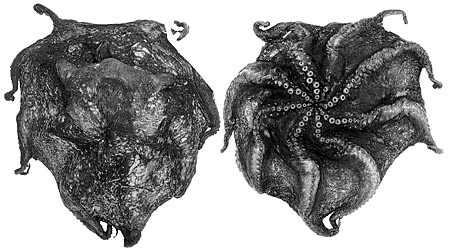Opisthoteuthis robsoni
Steve O'Shea, Richard E. Young, and Michael VecchioneIntroduction
Opisthoteuthis robsoni is a moderately large species with a total length of 362 mm. It is known from 4 male animals.
Characteristics
- Arms and web
- Arms subequal in length.
- Arms I in males without increased robustness.
- Males with proximal fields of enlarged suckers present; distal field weak. All arms with equal enlargement.
- Proximal sucker field (males): largest sucker diameter 8.8-15.5% of ML; grossly enlarged suckers may form biserial arrangement.
- Distal sucker field (males): weak or no sucker enlargement, marked by crowding of suckers at web margin, sometimes with biserial arrangement.
- Sucker size distribution (males): first 2 or 3 suckers moderate in size; next 7-8 suckers abruptly enlarged and bulbous, 6-8 grossly so; next 30-35 suckers with reduced diameter and similar sized; terminal 35-40 suckers, beyond point of intersection of arm and web, gradually decrease to tip.
- Maximum sucker count 89 (362 mm ML).
- Web nodule/supports not reported.
- First cirrus between suckers 2 and 4.
- Maximum cirrus length 3-8% of ML or 0.3-0.6 times maximum enlarged sucker diameter.
Comments
The above description is from O'Shea (1999). More details of the description of O. robsoni can be found here.
O. robsoni differs from all members of the genus (where males are known), except O. mero and O. depressa, in lacking distal fields or at least lacking an increase in sucker size in the distal fields. O. depressa differs from the other two in having more enlarged suckers on each arm of the proximal field (i.e., 16 vs 5-8). O. robsoni differs from O. mero in having a unilobular rather than a bilobular digestive gland.
Distribution
The type locality is off the east coast of New Zealand in the region of the Chatham Rise, 42°42'S,174°28'E, 1600 m. O. robsoni is known only from this area (O'Shea, 1999).
References
O'Shea, Steve. 1999. The Marine Fauna of New Zealand: Octopoda (Mollusca: Cephalopoda). NIWA Biodiversity Memoir 112: 280pp.
About This Page
Steve O'Shea

Oceanic Sciences Research Institute, Auckland University of Technology, Auckland, New Zealand

University of Hawaii, Honolulu, HI, USA

National Museum of Natural History, Washington, D. C. , USA
Page copyright © 2016 , , and
All Rights Reserved.
- First online 13 May 2003
Citing this page:
O'Shea, Steve, Richard E. Young, and Michael Vecchione. 2003. Opisthoteuthis robsoni . Version 13 May 2003 (under construction). http://tolweb.org/Opisthoteuthis_robsoni/20167/2003.05.13 in The Tree of Life Web Project, http://tolweb.org/









 Go to quick links
Go to quick search
Go to navigation for this section of the ToL site
Go to detailed links for the ToL site
Go to quick links
Go to quick search
Go to navigation for this section of the ToL site
Go to detailed links for the ToL site